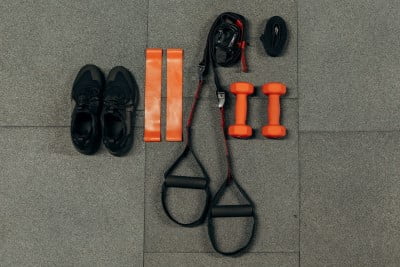Have you ever wondered how to improve your performance? Today we are going to discuss principles of exercise that will help you in your fitness program.

Physical fitness is dependent on many different factors. You can’t achieve your goal just by going to the gym regularly. You need to consider the principles of exercise while designing any exercise program.
Before beginning your workout, you need to consider:
- Warm-up for about 10-15 minutes, then
- 20-60 minutes of exercise training
- 10 minutes cool-down or static stretching at the end
Principles Of Exercise:
1) Overload
Overload is one of the important principles of exercise. It refers to placing a greater than normal amount of stress on the body. For an exercise to have an effect on your body, some level of stress must be placed on it.
Stress on the body will make it function at a higher capacity, thereby increasing endurance or strength.
2) Specificity
The principle of specificity states ‘the type of physical change you desire in your body relates directly to the type of exercise you choose’
For example: if you want to increase your muscle strength, you need to do weight training. If your goal is to improve your cardiovascular fitness, then you have to place cardiovascular demands on the body.
3) Progression
It refers to the gradual increase of the level and intensity of exercise.
RULES OF PROGRESSION
- Increase only one FITT(to be discussed below) component at a time. It is best to increase duration first.
- Increase your exercise workout by no mere than 10% per week. Increasing too early can lead to injury.
- Stop exercising and seek immediate health care if you experiencing any:
- Tightness in your chest
- severe shortness of breath
- Chest pain
- Heart palpitations
- Dizziness, faintness, or feeling sick to your stomach
4) Reversibility
Physical strength and endurance is reversible process. The results of physical fitness are not permanent. If you become inactive for a longer period of time, you may lose strength or endurance. It is important to maintain your fitness level with regular activity.
5) Consistency
It is one of the essential principles of exercise. Consistency is a key to any fitness program. No matter what your fitness goal is, you have to be consistent to achieve it.
The only way to improve maintain or improve fitness levels is to be consistent. You have to participate in physical activities on a frequent and regular basis.
6) Individual differences
We all differ in fitness levels. What works for one person may not work as well for another. Everyone responds differently even to the same training program. This response depends on many factors like genetic makeup, the initial fitness level of individuals, and their health status.
The training program should be designed according to this principle of exercise. Trainers or physiotherapists while designing workout plans for their client/patient must consider all these factors.
7) Safety
TRAIN, DON’T STRAIN.
Safety involves being aware of all the aspects of your exercise routine. From learning the correct way to use a machine to know the limits of your body. There are numerous essential things that you should pay attention to in order to keep your body safe.
8) Rest
This is one of the most important yet most ignored principles of exercise. Your body needs rest to recover from strenuous workouts. Back-to-back high-intensity workouts break down muscles. Avoiding rest doesn’t allow them to grow stronger.
FITT PRINCIPLES OF EXERCISE
The FITT guidelines are an easy way to remember the essential facts for a good and effective workout.
FITT stands for:
- F=Frequency
- I=Intensity
- T=Time/Duration
- T=Type of activity
FREQUENCY
Frequency means ‘HOW OFTEN’. Exercise should be done 3-5 times a week. Training 3 days per week produces significant effects of training on the body. More frequent exercising provides few additional benefits and may increase the likelihood of injuries. Significant fitness loss occurs within 2 weeks of becoming inactive.
INTENSITY
It means ‘HOW HARD’. Intensity can be light, moderate, or vigorous.
Light intensity includes slow walking. Moderate includes brisk walking and vigorous includes running(>5mph).
There are several ways to monitor exercise intensity. Five popular methods include:
- Maximum heart rate (HRmax) method
- Heart rate reserve (HRR) method
- Rte of percived exertion method
- Calories burned
- Talk-test method
TIME
Time means ‘HOW LONG’. A cardiorespiratory endurance session should vary from 20 to 60 minutes. Single session or several sessions of 10 or more minutes each. It is optimal for gaining significant aerobic and fat-burning benefits.
This does not include the warm-up and cool-down phases of your program.
TYPE OF ACTIVITY
To choose the best exercise for you, consider the following:
- Choose exercise that involves several muscle groups and that is weight bearing. This will require the greatest amount of energy and oxygen to perform.
- Choose the exercises that you enjoy the most.
- Alleviate boredom and decrease your risk of injury by cross-training.
TIPS FOR WORKOUTS:
1. Hard workout days should be followed by easy workout dats or rest.
2. Alternate between lifting weights and aeroboc exercise from day to day.
3. High energy days should be your harder workout days.
4. On low energy days simply rest or perform a light workout.
5. Most of all: Listen to your body!
Conclusion:
When designing your fitness program, make sure to follow the FITT guidelines. Always warm up and cool down, and progress slowly. Choose activities that are appropriate for your fitness level, patience, interests, and schedule. Most importantly, have fun!
